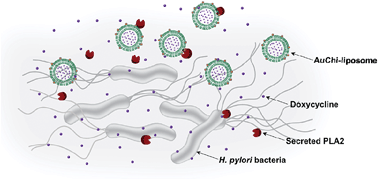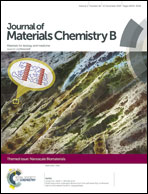Phospholipase A2-responsive antibiotic delivery via nanoparticle-stabilized liposomes for the treatment of bacterial infection
Abstract
Adsorbing small charged nanoparticles onto liposome surfaces to stabilize them against fusion and payload leakage has resulted in a new class of liposomes capable of environment-responsive drug delivery. Herein, we engineered a liposome formulation with a lipid composition sensitive to bacterium-secreted phospholipase A2 (PLA2) and adsorbed chitosan-modified gold nanoparticles (AuChi) onto the liposome surface. The resulting AuChi-stabilized liposomes (AuChi-liposomes) showed prohibited fusion activity and negligible drug leakage. However, upon exposure to either purified PLA2 enzyme or PLA2 secreted by Helicobacter pylori (H. pylori) bacteria in culture, AuChi-liposomes rapidly released the encapsulated payloads and such responsive release was retarded by adding quinacrine dihydrochloride, a PLA2 inhibitor. When loaded with doxycycline, AuChi-liposomes effectively inhibited H. pylori growth. Overall, the AuChi-liposomes allowed for smart “on-demand” antibiotic delivery: the more enzymes or bacteria present at the infection site, the more drugs will be released to treat the infection. Given the strong association of PLA2 with a diverse range of diseases, the present liposomal delivery technique holds broad application potential for tissue microenvironment-responsive drug delivery.

- This article is part of the themed collection: Nanoscale Biomaterials

 Please wait while we load your content...
Please wait while we load your content...